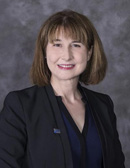题目:Material Design and Discovery
报告人:Professor Susan B. Sinnott
Department Head and Professor, Materials Science & Engineering,
The Pennsylvania State University, University Park, Pennsylvania)
报告时间:8月16日(周四)上午9:00-10:00
报告地点:师昌绪楼403室
报告摘要: A driving force for research is the discovery and design of new materials to improve existing technologies or enable new applications. Material modeling methods are now widely applied in pursuit of this objective. This presentation will review the evolution of some common material modeling methods and their integration with cutting-edge experimental techniques. Illustrative applications will be discussed within the context of layered or two-dimensional materials and carbide-derived carbon materials. The presentation will conclude with a discussion of the future outlook of materials modeling within the context of material design and discovery.
 Biography: Dr. Sinnott received her B.S. degree with honors in Chemistry from the University of Texas in 1987 and her doctoral degree in Physical Chemistry from Iowa State University in 1993. From there, she joined the Naval Research Laboratory, Surface Chemical Branch, in Washington D.C. as a National Research Council Post Doctoral Associate until 1995. Afterwards, Dr. Sinnott became an Assistant Professor in the Department of Chemical & Materials Engineering at the University of Kentucky through 2000. She then began her tenure at the University of Florida, where she was an Associate Professor of Materials Science and Engineering until her promotion in 2005 to the rank of Professor of Materials Science and Engineering. In 2007 she became an Affiliate Professor in the Department of Mechanical and Aerospace Engineering, and in 2012 she was named the Alumni Professor of Materials Science. Dr. Sinnott also became a member of the Quantum Theory Project in 2011 and the Director of the Cyberinfrastructure for Atomistic Simulation (CAMS) in 2012. In 2015 Dr. Sinnott joined the Pennsylvania State University as Professor and Department Head of Materials Science and Engineering. Currently, she extensively serves the scientific community of materials. He is the Editor-in-Chief of Computational Materials Science, Associate Editor of the Journal of the American Ceramic Society, and Principal Editor of the Journal of Materials Research. He has been elected as the fellow of the American Physical Society, Fellow of the Materials Research Society, Fellow of the American Ceramic Society, American Institute of Physics Advisory Committee on Physics Today, Fellow of the American Association for the Advancement of Science, and Fellow of the American Vacuum Society as well as Japan Society for the Promotion of Science Fellow, 2001, and so on.
Biography: Dr. Sinnott received her B.S. degree with honors in Chemistry from the University of Texas in 1987 and her doctoral degree in Physical Chemistry from Iowa State University in 1993. From there, she joined the Naval Research Laboratory, Surface Chemical Branch, in Washington D.C. as a National Research Council Post Doctoral Associate until 1995. Afterwards, Dr. Sinnott became an Assistant Professor in the Department of Chemical & Materials Engineering at the University of Kentucky through 2000. She then began her tenure at the University of Florida, where she was an Associate Professor of Materials Science and Engineering until her promotion in 2005 to the rank of Professor of Materials Science and Engineering. In 2007 she became an Affiliate Professor in the Department of Mechanical and Aerospace Engineering, and in 2012 she was named the Alumni Professor of Materials Science. Dr. Sinnott also became a member of the Quantum Theory Project in 2011 and the Director of the Cyberinfrastructure for Atomistic Simulation (CAMS) in 2012. In 2015 Dr. Sinnott joined the Pennsylvania State University as Professor and Department Head of Materials Science and Engineering. Currently, she extensively serves the scientific community of materials. He is the Editor-in-Chief of Computational Materials Science, Associate Editor of the Journal of the American Ceramic Society, and Principal Editor of the Journal of Materials Research. He has been elected as the fellow of the American Physical Society, Fellow of the Materials Research Society, Fellow of the American Ceramic Society, American Institute of Physics Advisory Committee on Physics Today, Fellow of the American Association for the Advancement of Science, and Fellow of the American Vacuum Society as well as Japan Society for the Promotion of Science Fellow, 2001, and so on.



